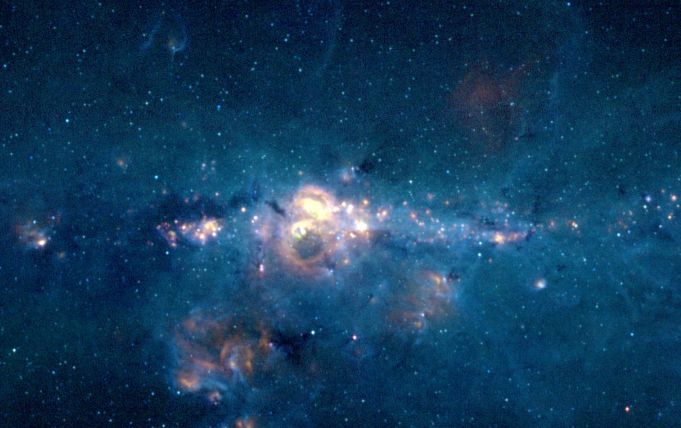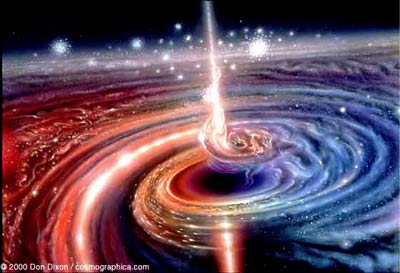If you were to travel to the center of our galaxy or observe it from Earth, you would see an extremely massive but compact object at the center of the galaxy. In other words, you would see a supermassive black hole. You would also see closely packed stars around the black hole and patterns of X-ray flares coming from the core.

Sadly, it is not possible to travel to our galactic center or see it from Earth. There is no technology capable of travelling there yet and the path to the center of our galaxy is covered with interstellar gases and dust that absorb light making it impossible to see the core in visible light. It is like fog that hides the galactic center from our view.
Thanks to powerful electromagnetic radiation, we know what is at the center of our galaxy and other galaxies too. Astronomers observe the core of our galaxy at radio, gamma rays, hard X-ray, sub-millimeter and infrared radiation that can peer through the dust and gases to see the galactic center. This is how we known what we know about galactic centers.
So what is a Black Hole and How Does It Come to Be?
A black hole is an object that is so massive and at the same time so compact that nothing can escape its immense gravity. Not even light.
Normally, black holes result from the gravitational collapse of massive stars in an explosion leaving an object of infinite mass and gravitational force without any dimensions or volume.
Black holes grow in size by kidnapping and swallowing nearby stars, gases, dust and smaller black holes.
A supermassive black hole is the largest type of black hole. It may form when a small black hole consumes enough material and swells up to become supermassive.
The Black Hole at the Center of Our Galaxy
The back hole at the center of our galaxy is located about 25,000-28,000 light years away from the sun in the constellation Sagittarius. It is regulating star formation, consuming materials and growing in size.
Astronomers believe the center of our galaxy is very still. Our sun is part of a large disc of stars and gases in orbit around the center of the Milky Way galaxy. It takes our sun 200-250 million years to complete one orbit.
To determine the morphology of the black hole, scientists studied 28 stars at our galactic center.
It is extremely massive and could be 1 million to 2.5 billion times as massive as the sun. It is also extremely compact with a radius of less than 6.25 light years.
Stars near the center of our galaxy are closely packed together. If our sun were located there, the night sky would be spectacular.
The Discovery of the Black Hole at Our Galactic Center
In 1974, Sir Martin, a British astronomer, proposed that supermassive black holes could be found at the center of some of the galaxies in the universe.
Then Bruce Balick and Robert Brown, American radio astronomers, discovered a compact and variable radio signal coming from a large and extended radio source, which they named Sagittarius A* (Pronounced Sagittarius A star). Astrophysicists studied this radio source extensively at radio, optical and infrared wavelengths.
After observing the extremely high speed at which gas and stars orbited the Milky Way galactic center, astronomers began to believe that an extremely massive but compact object was located at the center of our galaxy. At this stage, they didn’t know whether it was a black hole or millions of closely packed stars. They had to make X-ray observations to confirm the identity of the supermassive object.
NASA’s Chandra X-ray Observatory confirmed that the long suspected black hole at the center of our galaxy exists.
Where Did The Supermassive Black Hole At The Center of Our Galaxy Come From?
There are different theories explaining its origin. One theory is that some supermassive black holes formed when the galaxies were formed.
Another theory is that a stellar-mass black hole could start consuming matter and become massive.
There is also a theory that such a supermassive black hole could form when clusters of smaller back holes come together to form a supermassive black hole.
Energetic Phenomenon at the Center of Our Galaxy
It is not just a black hole at our galactic center. There is high energy activity there too.

The core of our galaxy has a very powerful radio source known as Sagittarius A star. This is a potent source of X-rays and astronomers have detected patterns of X-ray flares coming from the core.
Astronomers think the emissions are caused by the black hole devouring surrounding matter including gases. Only extremely hot gas emits X-rays. Gas that is being compressed as it falls towards a black hole would emit X-rays.
What Is At the Center of Other Galaxies?
Our galaxy is one of the billions of galaxies that occupy the universe. Cosmologists believe that black holes are at the center of most if not all of the galaxies in the universe.
Even with the confirmation that an extremely massive black hole lies at the center of our galaxy, there are still many unanswered questions and we still have a long way to go in discerning what goes on at the center of our galaxy and that of other galaxies.
